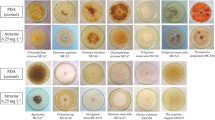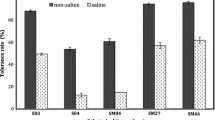Abstract
This work aimed to study the production of laccase from Pleurotus ostreatus DSM 1833 and Phoma sp. UHH 5-1-03 using banana peels as alternative carbon source, the subsequent partial purification and characterization of the enzyme, as well the applicability to degrade endocrine disruptors. The laccase stability with pH and temperature, the optimum pH, the K m and V max parameters, and the molar mass were determined. Tests were conducted for assessing the ability of degradation of the endocrine disruptors t-nonylphenol, bisphenol A, and 17α-ethinylestradiol. Laccase production of 752 and 1,117 U L−1 was obtained for Phoma sp. and P. ostreatus, respectively. Phoma sp. laccase showed higher stability with temperature and pH. The laccase from both species showed higher affinity by syringaldazine. The culture broth with banana peels induced the production of two isoforms of P. ostreatus (58.7 and 21 kDa) and one of Phoma sp. laccase (72 kDa). In the first day of incubation, the concentrations of bisphenol A and 17α-ethinylestradiol were reduced to values close to zero and after 3 days the concentration of t-nonylphenol was reduced in 90% by the P. ostreatus laccase, but there was no reduction in its concentration by the Phoma sp. laccase.





Similar content being viewed by others
References
Liu, P. (2006). Fungal laccases—Occurrence and properties. FEMS Microbiology Reviews, 30, 215–242.
Junghanns, C., Krauss, G., & Schlosser, D. (2008). Potential of aquatic fungi derived from diverse freshwater environments to decolourise synthetic azo and anthraquinone dyes. Bioresource Technology, 99, 1225–1235.
Junghanns, C., Parra, R., Keshavarz, T., & Schlosser, D. (2008). Towards higher laccase activities produced by aquatic ascomycetous fungi through combination of elicitors and an alternative substrate. Engineering in Life Sciences, 8, 277–285.
Junghanns, C., Pecyna, M. J., Böhm, D., Jehmlich, N., Martin, C., Von Bergen, M., Schauer, F., Hofrichter, M., & Schlosser, D. (2009). Biochemical and molecular genetic characterisation of a novel laccase produced by the aquatic ascomycete Phoma sp. UHH 5-1-03. Applied Microbiology and Biotechnology, 84(6), 1095–1105. Published online: May 12, 2009.
Pezzella, C., Autore, F., Giardina, P., Piscitelli, A., Sannia, G., & Faraco, V. (2009). The Pleurotus ostreatus laccase multi-gene family: Isolation and heterologous expression of new family members. Current Genetics, 55, 45–57.
USEPA—United States Environmental Protection Agency. Endocrine disruptor screening program. Available from: http://www.epa.gov/endo/pubs/edspoverview/whatare.htm Accessed Dec 2009.
Cajthaml, T., Křesinová, Z., Svobodová, K., & Möder, M. (2009). Biodegradation of endocrine-disrupting compounds and suppression of estrogenic activity by ligninolytic fungi. Chemosphere, 75, 745–750.
Saito, T., Katsuya, K., Yokogawa, M. N., & Nobuyoshi, Y. (2004). Detoxification of bisphenol A and nonylphenol by purified extracellular laccase from a fungus isolated from soil. Journal of Bioscience and Bioengineering, 98, 64–66.
Junghanns, C., Moeder, M., Krauss, G., Martin, C., & Schlosser, D. (2005). Degradation of the xenoestrogen nonylphenol by aquatic fungi and their laccases. Microbiology, 151, 45–57.
Cabana, H., Jiwan, J., Rozenberg, R., Elisashvili, V., Penninckx, M., Agathos, S. N., & Jones, J. P. (2007). Elimination of endocrine disrupting chemicals nonylphenol and bisphenol A and personal care product ingredient triclosan using enzyme preparation from the white rot fungus Coriolopsis polyzona. Chemosphere, 67, 770–778.
Rodgers, C., Blanford, C., Giddens, S., Skamnioti, P., Armstrong, F., & Gurr, S. (2010). Designer laccases: A vogue for high-potential fungal enzymes? Trends in Biotechnology, 28, 63–72.
Stajić, M., Persky, L., Friesem, D., Hadar, Y., Wasser, S. P., Nevo, E., & Vukojević, J. (2006). Effect of different carbon and nitrogen sources on laccase and peroxidases production by selected Pleurotus species. Enzyme and Microbial Technology, 38, 65–73.
Elisashvili, V., Penninckx, M., Kachlishvili, E., Tsiklauri, N., Metreveli, E., Kharziani, T., & Kvesitadze, G. (2008). Lentinus edodes and Pleurotus species lignocellulolytic enzymes activity in submerged and solid-state fermentation of lignocellulosic wastes of different composition. Bioresource Technology, 99, 457–462.
Naranjo, L., Urbina, H., De Sisto, A., & Leon, V. (2007). Isolation of autochthonous non-white rot fungi with potential for enzymatic upgrading of Venezuelan extra-heavy crude oil. Biocatalysis and Biotransformation, 25, 341–349.
Eichlerová, L., Homolka, L., & Nerud, F. (2003). Decolorization of orange G by Pleurotus ostreatus monokaryotic isolates with different laccase activity. Folia Microbiologica, 48, 775–779.
Giardina, P., Palmieri, G., Scaloni, A., Fontanella, B., Faraco, V., Cennamo, G., & Sannia, G. (1999). Protein and gene structure of a blue laccase from Pleurotus ostreatus. Biochemical Journal, 341, 655–663.
Liu, L., Lin, Z., Zheng, T., Lin, L., Zhenga, C., Lin, Z., Wang, S., & Wanga, Z. (2009). Fermentation optimization and characterization of the laccase from Pleurotus ostreatus strain 10969. Enzyme and Microbial Technology, 44, 426–433.
Martin, C., Pecyna, M., Kellner, H., Jehmlich, N., Junghanns, C., Von Benndorf, D., Bergen, M., & Schlosser, D. (2007). Purification and biochemical characterization of a laccase from the aquatic fungus Myrioconium sp. UHH 1-13-18-4 and molecular analysis of the laccase-encoding gene. Applied Microbiology and Biotechnology, 77, 613–624.
Otto, B., Schlosser, D., & Reisser, W. (2010). First description of a laccase-like enzyme in soil algae. Archives of Microbiology, 11, Published online: July 2010.
Neuhoff, V., Arold, N., Taube, D., & Ehrhardt, W. (1988). Improved staining of proteins in polyacrylamide gels including isoelectric focusing gels with clear background at nanogram sensitivity using Coomassie Brilliant Blue G-250 and R-250. Electrophoresis, 9, 255–262.
Elisashvili, V., Kachlishvili, E., & Penninckx, M. (2008). Efect of growth substrate, method of fermentation, and nitrogen source on lignocellulose-degrading enzymes production by white-rot basidiomycetes. Journal of Industrial Microbiology and Biotechnology, 35, 1531–1538.
Schlosser, D., Grey, R., & Fritsche, W. (1997). Patterns of ligninolytic enzymes in Trametes versicolor. Distribution of extra- and intracellular enzyme activities during cultivation on glucose, wheat straw and beech wood. Applied Microbiology and Biotechnology, 47, 412–418.
Moldes, D., Lorenzo, M., & Ma Sanromán, A. (2004). Different proportions of laccase isoenzymes produced by submerged cultures of Trametes versicolor grown on lignocellulosic wastes. Biotechnology Letters, 26, 327–330.
Gern, R. M. M., Wisbeck, E., Rampinelli, J. R., Ninow, J. L., & Furlan, S. A. (2008). Alternative medium for production of Pleurotus ostreatus biomass and potential antitumor polysaccharides. Bioresource Technology, 99, 76–82.
Palmieri, G., Giardina, P., Bianco, C., Scaloni, A., Capasso, A., & Sannia, G. (1997). A novel white laccase from Pleurotus ostreatus. Journal of Biological Chemistry, 272, 31301–31307.
Palmieri, G., Cennamo, G., Faraco, V., Amoresano, A., Sannia, G., & Giardina, P. (2003). Atypical laccase isoenzymes from copper supplemented Pleurotus ostreatus cultures. Enzyme and Microbial Technology, 33, 220–230.
Galhaup, C., Goller, S., Peterbauer, C. K., & Strauss, J. (2002). Characterization of the major laccase isoenzyme from Trametes pubescens and regulation of its synthesis by metal ions. Microbiology, 148, 2159–2169.
Xu, F. (1996). Oxidation of phenols, anilines and benzenethiols by fungal laccases: Correlation between activity and redox potentials as well as halide inhibition. Biochemistry, 35, 7608–7614.
Emaga, T. H., Robert, C., Ronkart, S. N., Wathelet, B., & Paquot, M. (2008). Dietary fibre components and pectin chemical features of peels during ripening in banana and plantain varieties. Bioresource Technology, 99(10), 4346–4354.
Auriol, M., Filali-Meknassi, Y., Adams, C., Tyagi, R., Noguerol, T., & Piña, B. (2008). Removal of estrogenic activity of natural and synthetic hormones from a municipal wastewater: Efficiency of horseradish peroxidase and laccase from Trametes versicolor. Chemosphere, 70, 445–452.
Acknowledgments
We gratefully acknowledge Dr. Rainer Jonas for the support during the internship in Germany as well as InWent-International Capacity Building. We also acknowledge the Santa Catarina State Research Foundation—FAPESC and the Coordination for the Improvement of Higher Level Education Personnel—CAPES for the financial support. Furthermore, we want to thank R. Boetz (UFZ) for the excellent technical assistance.
Author information
Authors and Affiliations
Corresponding author
Rights and permissions
About this article
Cite this article
Libardi Junior, N., Gern, R.M.M., Furlan, S.A. et al. Laccase Production by the Aquatic Ascomycete Phoma sp. UHH 5-1-03 and the White Rot Basidiomycete Pleurotus ostreatus DSM 1833 During Submerged Cultivation on Banana Peels and Enzyme Applicability for the Removal of Endocrine-Disrupting Chemicals. Appl Biochem Biotechnol 167, 1144–1156 (2012). https://doi.org/10.1007/s12010-012-9601-3
Received:
Accepted:
Published:
Issue Date:
DOI: https://doi.org/10.1007/s12010-012-9601-3




